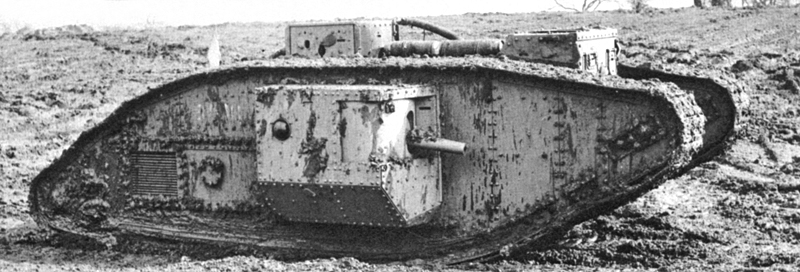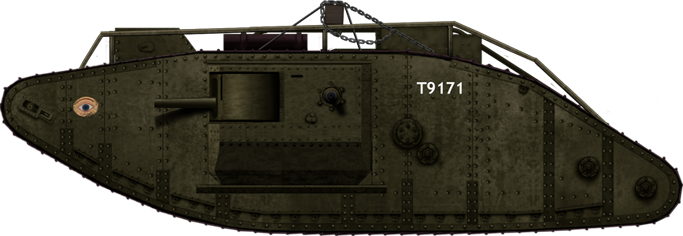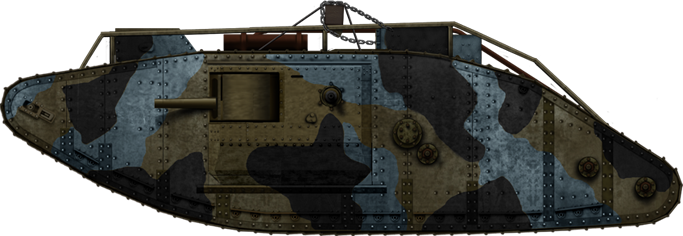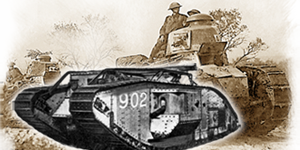A Brand New Design
The Mark IV was an efficient model, but many issues shown by war experience had still to be solved by mid-1917. A new design, studied by William Tritton, was ready within days, incorporating a set of brand new features, including a new hull, improved transmission, engine and steering system. But while a wooden mock-up was built, industrial priorities dictated a radical turn. When it appeared that the new transmission and steering system originally planned for the Mark IV were ready for production, the War Cabinet decided to urgently built this improvement of the Mark IV, renamed Mark V. Some features of the original new design will be implemented in the post-war variants of the Mark V.Design of the Mark V
The Mark V kept all the external features of the Mark IV including the hull, rollers and tracks in order not to disrupt production. However a new, more powerful drive-train and transmission were ready at the beginning of 1917 and tests ordered by William Stern were conducted on modified Mark IVs. These systems included petrol-electric schemes, hydraulic systems, a multiple clutch system (a single driver was needed), and Wilson's own epicylcic gearbox design (4 forward gears , one reverse). A new, more powerful 19 liter six cylinder in-line Ricardo engine (150 bhp) was chosen (giving a power/weight ratio of 5.2 bhp/ton). Autonomy was 70 km (45 mi) with 450 liters fuel capacity (93 gallons), or enough for approximately 10 hours on a rugged terrain. The hull was fitted with a second rear cabin with observation slits and hinged sides allowing the fitting of an unditching wooden beam. The rear part of the hull also received an additional machine-gun mount.Production of the Mark V started at the Metropolitan Carriage and Wagon factory in the fall of 1917. The first batch arrived in France in May 1918, and total production was 400, of which 200 male and 200 female. The last were delivered by mid-1919.
The Mark V in Action
Only available in small quantities by mid-1918, the impact of the Mark V was not significant, but three months later, they were numerous enough to make a difference. The first major engagement was the battle of Hamel, on 7 July 1918, when 60 tanks led the victorious offensive of the Australian troops against the German lines. Later, in August, 288 Mark V and V*s were involved, together with numerous Mark A Whippet, in the battle of Amiens, a complete success. The Mark V took part in eight major offensives until the armistice. At the same time, Canadian and US Army troops trained on Mark V's. The 301st American Heavy Tank Battalion was entirely equipped with these, and were thrown in action from September to November 1918 against the Hindenburg line with heavy losses (18 of 21 were lost or disabled). After the armistice, 70 Mark V's were given by the British government to the White Russian faction fighting against the Bolsheviks. But as the situation worsened, a growing number of captured Mark V's took action under the red flag. There is no record of duels between red and white Mark V's, but they ended as a substantial part of the Red Army and were thoroughly studied. They took part in several actions in 1921, including the battle of Tbilissi. Lithuanian and Latvian Mark V's were still active in 1939.Mk.V variants
Four variants were built during and after the war. The first was the famous "hermaphrodite", a bunch of modified "females" to include a "male" artillery sponson. These mix type tanks were conceived in response to the growing number of captured German Mark I and IV tanks. The giant A7V was very rare at that time. The Mark V* or "star" was a lengthened (six feet) version designed by Tritton during the fall of 1917, to deal with the Hindenburg line, and its very wide trenches (3.47 m/11.39 ft). Major Philip Johnson of the Central Tank Corps Workshops took leadership of this project. The pre-serie tanks were conversions of regular, stretched Mark Vs with reinforced heavy girders. 400 male and 200 female were ordered, of which 579 were built by March 1919. Some arrived in time for the last offensives of November 1918. They were fitted with guidance rails for the unditching beam, two extra machine-guns in their rear cupola, two side doors with extra machine-gun mounts and a total weight of 33 tons. The extra space was thought to be best used for troop transport, but the internal conditions were still unbearable.The Mark V** was proposed by Major Wilson to cope with the main limitation of the Mark V*, a cruel lack of agility. Turning circle was enormous and the added weight and length caused enormous tensions on the steering system. It included new widened tracks (67.3 cm/26.5 in) with a stronger curve on the lower run reducing contact (but increase ground pressure), a bored out engine, pushed to 225 bhp, relocated further back in a lower position, and better compartmentalization. Out of an initial order of 700, only 25 were delivered by January 1919.
The Mark V*** was a paper project, a largely improved version, part of a contingency plan in case the Liberty (Mark VIII) would fail. Improved protection, speed and crew comfort, while using as many parts as possible from the Mark V were the main objective. Prospective production for 1919 was 2000 units.
Links
The Mk.I family on WikipediaTank Mk.V specifications |
|
| Dimensions | 8.50x3.69/3.23(male/female)x2.64 m (27.8x12.1/10.59x8.66 ft) |
| Total weight, battle ready | 28/29 (female/male) tons |
| Crew | 8 |
| Propulsion | Ricardo 6-in line 16 liters petrol, 150 bhp |
| Speed | 8 km/h (5 mph) |
| Range | 45 km (27.96 mi) |
| Armament | Male : 2x6pdr (57 mm)+ 4xHotchkiss 7.7 mm (0.303 in) machine guns Female : 6xHotchkiss 7.7 mm (0.303 in) machine guns |
| Armor | From 8 (roof and belly) to 16 mm front (0.31 to 0.62 in) |
| Total production | 400 |

One Mark V on the Western Front (Imperial War Museum). Many Mark Vs were also seen in action in the sands of Palestine and the Middle East and in the snow of Russia, in 1921.

A Mark V*, the main, lengthened variant of the Mark V, stretched by 1.82 m (6 feet) to cope with the large antitank trenches of the Hindenburg Line. Its lack of agility was a big issue.

A Mark V**, featuring improved tracks, engine and other minor improvements. Only 25 were completed after the war.

The Mark V was the last evolution of the Mark I lineage, the brainchild of William Tritton and Major Wilson. Here is a standard Mark V male, early production, May 1917. Notice the factory standard dark olive livery and the "eye" painted on the front, a reference to the "eyes" of ancient ships .

A camouflaged late Mark V hermaphrodite. On the other side, a machine-gun sponson was fitted. Multi-pattern liveries were applied on site, with provisional, regulated colors. White, pale blue, brown, dark grey, black, were commonly used in spotted patterns, with or without black borders (French 1918 standard livery). The last Mark Vs were delivered well after the armistice.

A Mark V*. The star, or Mk.V*, and double star, or Mk.V**, were lengthened versions designed to assault the Hindendurg line, presenting very large antitank trenches. Attempts to use the larger hull to transport some infantry were doomed to fail due to the extreme conditions inside. It was hot, extremely noisy and filled with poisonous gases, not counting the shrapnel produced at every impact. The soldiers started feeling ill long before the tanks reached their destination. The Mark V** was equipped with a new engine and new tracks, but none were completed before the war ended.

The Great War
 Austria-Hungary
Austria-Hungary Belgium
Belgium British Empire
British Empire France
France German Empire
German Empire Italy
Italy Russia
Russia USA
USAWW1 tanks posters

